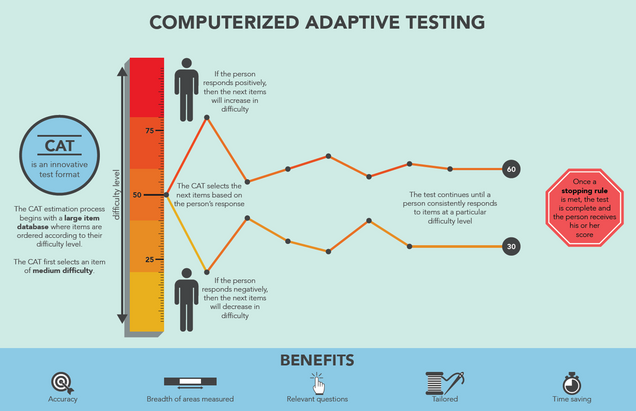How Does a Computerized Adaptive Test Work? View our New LIBRE Infographic
Have you ever answered a health questionnaire and realized that half of the questions didn’t have anything to do with you? We don’t want you wasting your time – we’re all busy and every extra free minute can mean a lot. A Computerized Adaptive Test (CAT) is an approach to patient-reported assessment that takes your time into consideration. A CAT uses state-of-the-art technology to assess each individual, providing a precise score by selecting questions that are tailored to each participant. With the CAT approach, a person is not required to respond to irrelevant questions. To introduce how a CAT works, we developed a new infographic seen below:

CATs are based on a large group of questions that are organized based on difficulty and how much information a question gives for a particular population. Each person begins by answering a question in the mid-range level of difficulty, and then the CAT will select the next question with a different difficulty level based on the individual’s response. For example, a mid-range question about a person’s ability to move around would be “On a scale of 1 to 5, with 1 being not difficult at all to 5 being extremely difficult, how difficult is it to walk up a hill?” If a person answers 1, she will be asked an easier question, such as “How difficult is it to walk for one block without stopping?” If she answers 5 to the first question, she would be asked a more difficult question, such as “How difficult is it to jog for 2 miles?”
In the infographic, grey dots indicate the point at which a question is asked, and the line denotes whether the next question selected by the CAT is easier or more difficult. This pattern of selecting questions continues until either the CAT has asked a maximum number of questions, or the score estimate has reached a specified level of precision. Using a CAT approach, a precise score is estimated with only a few well-selected questions.
The LIBRE Profile uses CAT technology to measure the social reintegration after a burn injury. We want to be able to pinpoint areas in a burn survivor’s social life that might need more attention and more resources. LIBRE measures six domains of social reintegration: Relationships with Family & Friends, Social Interactions, Social Activities, Work & Employment, Romantic Relationships, and Sexual Relationships. The burn survivor responds to questions within each of these domains (if applicable), and is provided scores in each appropriate domain at the end. Scores are compared to other people in similar situations and to a non-burned population. These comparisons make it easier to figure out where more help is needed and where the burn survivor is doing particularly well.

